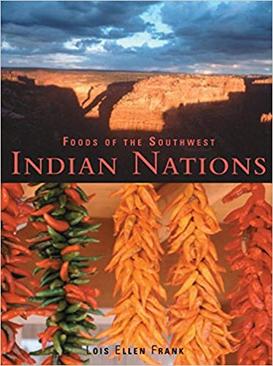Foods of the Southwest Indian Nations
Foods of the Southwest Indian Nations encompasses the diverse culinary practices, ingredients, and traditions of the Indigenous peoples of the Southwestern United States. This region, characterized by its arid deserts and high plateaus, is home to numerous tribes including the Navajo, Hopi, Zuni, and many others. The food traditions in this area are deeply intertwined with the cultural practices, spiritual beliefs, and survival strategies of these communities.
History and Cultural Significance[edit | edit source]
The foods of the Southwest Indian Nations are a direct reflection of the adaptation and resilience of these communities in the face of the region's harsh environmental conditions. Traditional diets were largely based on the "Three Sisters" - corn, beans, and squash - which are crops that support each other's growth. Corn, in particular, holds a place of spiritual and cultural significance among many tribes, serving as a staple food and a symbol of life.
Traditional Foods and Ingredients[edit | edit source]
Among the most iconic foods from this region is blue corn, a variety of maize that is ground into a fine meal and used in a variety of dishes, from tortillas to the ceremonial cake known as piki bread. Chiles, both green and red, are another cornerstone of Southwestern Indigenous cuisine, used to add flavor and heat to dishes.
Pinyon nuts, harvested from the pinyon pine trees native to the region, are a traditional source of protein and fat. They are often roasted and eaten whole or ground into a meal for use in various dishes. Game meats, such as deer, rabbit, and quail, along with fish from the region's rivers, provide additional protein sources.
Cooking Techniques and Dishes[edit | edit source]
Traditional cooking techniques often involve roasting or stone-grilling, which impart a distinctive flavor to the food. Earth ovens, dug into the ground and heated with hot stones, are used for slow-cooking meats and vegetables.
One of the most well-known dishes from this region is posole, a hearty stew made with hominy, meat, and chiles. Another staple is frybread, a simple flatbread that can be eaten alone or topped with various ingredients to make dishes like Navajo tacos.
Modern Influences and Adaptations[edit | edit source]
Today, the foods of the Southwest Indian Nations are experiencing a renaissance, with chefs and food activists working to revitalize traditional ingredients and cooking methods. This movement is not only about preserving cultural heritage but also about promoting food sovereignty and sustainability.
Challenges and Future Directions[edit | edit source]
Despite the rich culinary traditions of the Southwest Indian Nations, these communities face significant challenges related to food access and health. Many Indigenous peoples in the region live in food deserts, areas where it is difficult to obtain fresh, healthy food. Additionally, the loss of traditional lands and water rights has made it harder to grow crops and raise livestock.
Efforts to address these challenges include the revival of traditional farming practices, the establishment of community gardens, and initiatives to teach young people about their culinary heritage.
Conclusion[edit | edit source]
The foods of the Southwest Indian Nations are a testament to the resilience, creativity, and cultural richness of these communities. As efforts to preserve and revitalize these food traditions continue, they offer a pathway not only to improved health and sustainability but also to a deeper understanding of the region's Indigenous cultures.
Search WikiMD
Ad.Tired of being Overweight? Try W8MD's physician weight loss program.
Semaglutide (Ozempic / Wegovy and Tirzepatide (Mounjaro / Zepbound) available.
Advertise on WikiMD
|
WikiMD's Wellness Encyclopedia |
| Let Food Be Thy Medicine Medicine Thy Food - Hippocrates |
Translate this page: - East Asian
中文,
日本,
한국어,
South Asian
हिन्दी,
தமிழ்,
తెలుగు,
Urdu,
ಕನ್ನಡ,
Southeast Asian
Indonesian,
Vietnamese,
Thai,
မြန်မာဘာသာ,
বাংলা
European
español,
Deutsch,
français,
Greek,
português do Brasil,
polski,
română,
русский,
Nederlands,
norsk,
svenska,
suomi,
Italian
Middle Eastern & African
عربى,
Turkish,
Persian,
Hebrew,
Afrikaans,
isiZulu,
Kiswahili,
Other
Bulgarian,
Hungarian,
Czech,
Swedish,
മലയാളം,
मराठी,
ਪੰਜਾਬੀ,
ગુજરાતી,
Portuguese,
Ukrainian
Medical Disclaimer: WikiMD is not a substitute for professional medical advice. The information on WikiMD is provided as an information resource only, may be incorrect, outdated or misleading, and is not to be used or relied on for any diagnostic or treatment purposes. Please consult your health care provider before making any healthcare decisions or for guidance about a specific medical condition. WikiMD expressly disclaims responsibility, and shall have no liability, for any damages, loss, injury, or liability whatsoever suffered as a result of your reliance on the information contained in this site. By visiting this site you agree to the foregoing terms and conditions, which may from time to time be changed or supplemented by WikiMD. If you do not agree to the foregoing terms and conditions, you should not enter or use this site. See full disclaimer.
Credits:Most images are courtesy of Wikimedia commons, and templates Wikipedia, licensed under CC BY SA or similar.
Contributors: Prab R. Tumpati, MD

